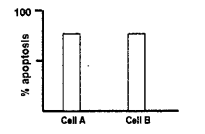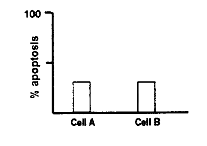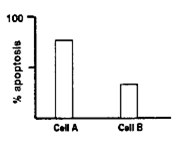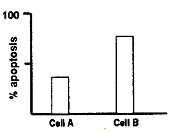 Multiple Choice Questions
Multiple Choice QuestionsThe following statements have been proposed for plant vegetative development:
(A) Lateral roots develop from epidermal cells.
(B) Shoot axillary meristem develops from shoot apical during differentiation of leaf primordial.
(C) Root cap is made up of dead cells.
(D) Lateral meristems and cylindrical meristems found in roots and shoots result in secondary growth.
Which of the above statements are true
(A) and (B)
(B) and (D)
(A), (B), and (D)
(C) and (D)
The part of the embryo from which the ectoderm, mesoderm, and endoderm are formed in chick is known as
primitive streak
hypoblast
epiblast
cytotrophoblast
Which protein secreted by the amphibian induces neural tissue formation by inhibiting Bone Morphogenetic Protein?
β-catenin
Noggin
Dickkopf
Dishevelled
The homologue of β-catenin in Drosophila is
Fushi tarazu
Engrailed
Armadillo
Cubitus interruptus
Which of the floral whorls is affected in apetala 3/ pistillata (ap3/ pi) mutants?
Sepals and Petals
Petals and stamens
Stamens and carpels
Sepals and stamens
Cells undergo apoptosis by two distinct and inter-connected pathways: extrinsic and intrinsic. The extrinsic pathway is activated by extracellular ligand binding to cell surface death receptors. Whenever an apoptotic stimulus activates intrinsic pathway, the pro-apoptotic Bax and Bak proteins become activated and induce the release of cytochrome C from mitochondria leading to caspase cascade activation resulting in apoptosis. In cell A, cytochrome C is introduced by microinjection whereas in cell B, cytochrome C is introduced by microinjection but Bax and Bak are inactivated. What will be the most appropriate apoptotic response type in both cells?




Polyspermy results when two or more sperms fertilize an egg. It is usually lethal since it results in blastomeres with different numbers and types of chromosomes. Many species therefore, have two blocks to polyspermy: the fast block and the slow block.
In case of sea urchins:
(A) the fast block is immediate and causes the egg membrane resting potential to rise which does not allow the sperm to fuse with the egg and is mediated by an influx of sodium ions.
(B) the fast block is immediate and causes the egg membrane resting potential to rise which does not allow the sperm to fuse with the egg and is mediated by an efflux of sodium ions.
(C) the slow block or cortical granule reaction is mediated by calcium ions.
(D) the slow block or cortical granule reaction is mediated by potassium ions.
Which of the above statements are true?
(A) and (C)
(A) and (D)
(B) and (C)
(B) and (D)
In an experiment, the cells that would normally become the middle segment of a Drosophila leg were removed from the leg forming area of the larva and were placed in the tip of the fly's antenna. Based on the "French flag" analogy for the operation of a gradient of positional information, which of the following statements is true?
The transplanted cells retain their committed status as leg cells, but respond to the positional information of their environment by becoming leg tip cells-ie., claws.
The transplanted cells are determined as leg cells and therefore would form a complete limb instead of an antenna.
The transplanted cells would intermingle with the cells present in the new environment and develop accordingly to give rise to an antenna.
The transplanted cells retain their committed status as leg cells and would develop to form a chimeric structure having a proximal region made of an antenna and the distal region ending in a complete leg.
Which of the inferences (A-D) given below would you draw from the following tissue transplantation experiments performed with the early and late gastrula stages of the newt?
| Host regions | Donor regions | Differentiation of donor tissue | |
| EARLY GASTRULA | |||
| (i) | Prospective neurons | Prospective epidermis | Epidermis |
| (ii) | Prospective epidermis | Prospective neurons | Neurons |
| LATE GASTRULA | |||
| (i) | Prospective neurons | Prospective epidermis | Neurons |
| (ii) | Prospective epidermis | Prospective neurons | Epidermis |
(A) Cells of early newt gastrula exhibit conditional development.
(B) Cells of early newt gastrula exhibit autonomous development.
(C) Cells of late newt gastrula exhibit conditional development.
(D) Cells of late gastrula exhibit autonomous development.
The correct inferences are:
(A) and (D)
(B) and (C)
(A) only
(D) only
Segmentation genes in Drosophila are divided into three groups (gap, pair-rule, and segment polarity) based on their mutant phenotype. below are some of their major genes expressed in a sequential manner (with respect to the groups) affecting segmentation pattern.
(A) hairy → paired → tailless → patched hunchback → even-skipped → Fushi tarazu → wingless
(B) hunchback → even-skipped → Fushi tarazu → wingless
(C) odd-skipped → giant → paired → wingless
(D) tailless → hairy → Fushi tarazu → gooseberry
Which of the above sequence(s) of genes expressed from early to late embryo is/ are correct?
(D) only
(A) and (B)
(C) and (B)
(B) and (D)
